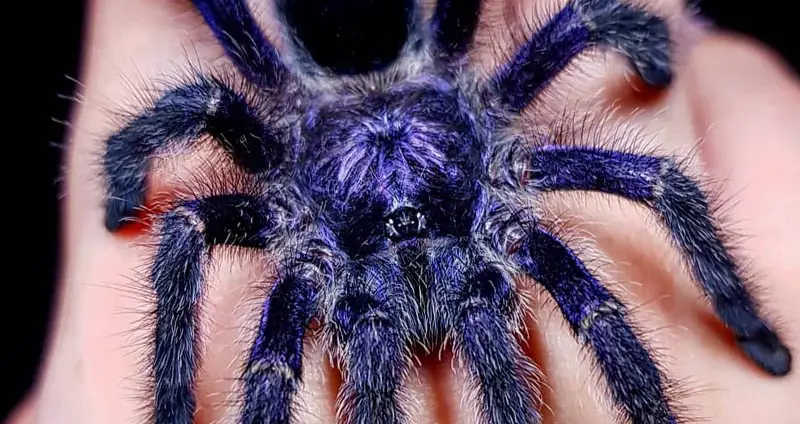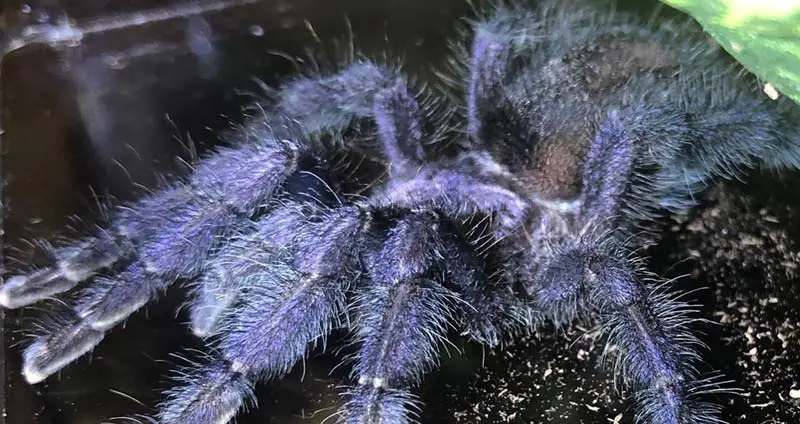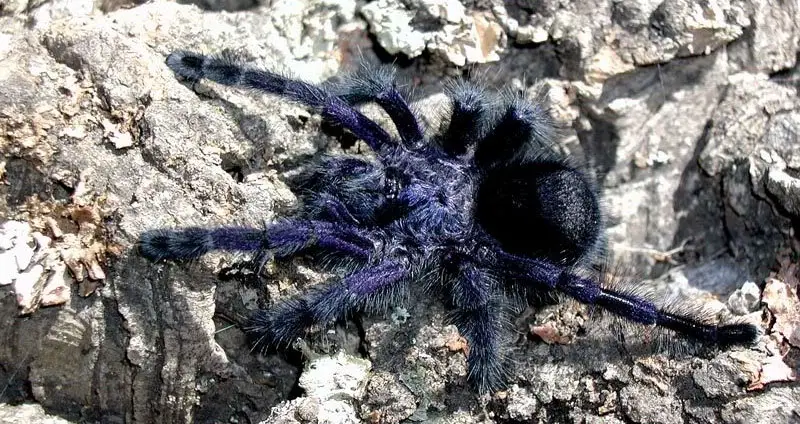With the existence of hundreds of different tarantulas, there’s bound to be some tarantulas that are friendly and some that are for experienced owners only.
The Avicularia purpurea, also known as the Purple Pink Toe tarantula, is definitely one of the favorite tarantulas among beginners and veterans. This tarantula is part of the very well-received genus Avicularia and comes with the added bonus of some stunning colors.
If you’re thinking about adding an Avicularia purpurea to your collections, there’s a few pieces of information that you should be aware of. This post will cover this tarantula’s appearance, temperament, and specific care requirements.
Table of Contents
Avicularia purpurea Care Sheet
Common Name |
Purple Pink Toe |
Species Type |
New world arboreal |
Habitat |
Found in the trees of the Amazon Rainforest, these tarantulas are exposed to consistently warm temperatures and high humidity year-round. |
Growth Rate |
Medium growth rate. Females and males reach full size within a couple of years. |
Adult Size |
Females reach a legspan of between 4″ and 5″, with males measuring slightly smaller. |
Lifespan |
Females regularly live to 12 years, while males often only live to 4 years. |
Enclosure |
The enclosure should be taller than it is wide, with plenty of materials to climb on and attach webbing to. Two inches of substrate should line the floor, a cork bark hide should be available, and you should maintain a bowl of fresh water. |
Temp/Humidity |
78°F to 82°F with about 65% to 75% humidity. |
Diet |
Good eater that can eat several adult crickets or one dubia roach per week. Often waits for prey to enter its web instead of going out and hunting for their food. |
Temperament |
A very docile tarantula that rarely throws up threat poses or flicks hairs. Mostly prefers to hide away instead of fighting off a predator. |
Experience Level |
Beginner – A simple tarantula to care for with a good temperament. Its environmental and dietary needs aren’t hard to meet, and beginners aren’t in much danger being in close proximity to this species. |
Average Cost |
Slings ~ $40, Males ~ $60, Females ~ $80+ |
Avicularia purpurea Appearance
The great appearance of this tarantula is one of the reasons why it’s such a popular pet. To begin with, Avicularia purpurea shares its appearance with a lot of other members of the Avicularia genus.
These tarantulas have a large, mostly black body that’s covered in a good amount of hair and has a slight iridescence in the correct lighting.
This particular species differs in its colors, though. Its entire body has a purple metallic iridescence to it, making it unlike most other tarantulas.
Despite the fact that it’s a “Pink Toe” tarantula, it doesn’t have the classic pink toes that are present on the Avicularia avicularia. Its feet do get darker towards the base, but they’re otherwise quite plain.
In terms of sizing, this is a tarantula that’s on the smaller end. Adult specimens grow to be around 4 to 5 inches in legspan, with females only slightly out-sizing the males.
Fortunately, the Avicularia purpurea isn’t a species that you need to wait for to see their beauty. They start off as fuzzy purple spiderlings and become more colorful as they grow.

Avicularia purpurea Temperament
The temperament of the Avicularia purpurea, and the entire Avicularia genus in general, is what really makes them a popular choice. This species is native to Ecuador — specifically the Amazon Rainforest.
They’re an arboreal species, meaning that they live in the trees and have developed impressive agility over their many years of existence. Don’t less this agility frighten you, though. It’s a characteristic that isn’t difficult to deal with.
In captivity, Avicularia purpurea is quite a docile tarantula and makes for an optimal pet. While there are quite a few tarantula species that aren’t great to handle, this is typically an exception.
However, despite the fact that many owners don’t have a problem handling this tarantula, it isn’t recommended that you handle any tarantula.
Avicularia Purpurea are new world tarantulas, meaning that they tend to be more calm and don’t resort to biting. However, they do have a form of self-defense if they’re threatened.
New world tarantulas have something called urticating hairs, which are short, spiny hairs that they can fling at you when threatened.
These can cause serious irritation and severe problems if inhaled or if they get into your eye. This genus also has the unique trait of launching excrement at any threats. Therefore, always use slow, predictable movements when handling your tarantula to avoid this from happening.
Housing Avicularia purpurea
If you’re looking to bring home one of these incredible tarantulas, you first need to make sure that you’ll be meeting all of their environmental needs. To begin with, this is an arboreal tarantula that spends its time in the trees of the Amazon Rainforest.
Therefore, it requires an enclosure that closely mimic the environment that it’s evolved in. Overall, though, there isn’t anything that separates this species’ needs from other species.
Optimal Enclosure
While Avicularia purpurea have specific environmental needs, those needs aren’t difficult to meet. As stated, this is an arboreal tarantula, so they’ll need to live in an enclosure that has more of a focus on height than floor space.
Since this is a species that doesn’t grow to be too large, they don’t need more than an average-sized terrarium. This “mini wide” terrarium by Exo Terra is 12″ x 12″ x 12″ and is big enough for adult specimens to comfortably live in.
The aforementioned terrarium is tall enough for Avicularia purpurea to make a sizable web towards the top of the enclosure, and the side opening prevents that webbing from getting damaged when accessing the enclosure.
Enclosure Decorations
It’s not enough to simply supply Avicularia purpurea with a good enclosure, though. Several essential accessories need to be included in order to make it suitable for this species.
First and foremost, about 2 inches of substrate need to line the bottom of the enclosure. This acts a comfortable base layer that helps to keep the enclosure clean and humidity levels consistent.
From the substrate, you need to build upward. This is an arboreal species, after all.
Begin by placing a large piece of cork bark up against one of the walls to act as a tree trunk that the tarantula can climb and web on. Fake plants can be used to spruce up a plain piece of cork bark.
Next you should place a water dish in one corner of the enclosure. Tarantulas drink water, so this dish will help prevent dehydration in addition to contributing towards the enclosure’s humidity.
Finally, add various other sticks, rocks, and fake plants to the enclosure to round it out and diversify it.

Enclosure Temperature/Humidity
Avicularia purpurea is quite a hardy species that encounters fairly tough conditions. Their natural habitat typically ranges from 79°F to 95°F with fairly high humidity.
Despite this large range, it’s typically recommended that you keep your tarantula’s enclosure around 78°F to 82°F. Fortunately, this is close to room temperature for a lot of people, so supplemental heating isn’t always necessary.
However, if your home is significantly below 78°F, then supplemental heating is a must. You can either utilize a space heater or a gentle heat lamp that doesn’t emit light.
In addition to a controlled temperature, this particular species needs their enclosure to have about 65% to 75% humidity. While this is quite a high number, it’s not very difficult to maintain.
By using a simple hygrometer, you can monitor the humidity level of the enclosure and use a spray bottle to dampen the substrate and webbing as needed.
Diet
These aren’t very large tarantulas, but they still need to eat a healthy diet in order to remain healthy.
Adult Avicularia purpurea eat about 2-3 times per week, and their wild diet consists of quite a few different foods. Since they don’t like to venture from their webbing, they eat whatever food happens to get caught in their web.
However, a captive-kept A. purpurea can have a relatively simply diet made up of crickets, roaches, and mealworms. Spiderlings should be fed smaller foods, such as pinhead crickets or smaller mealworms.
In order to keep their feeding close to what they’re used to in nature, many owners place the food directly into their tarantula’s webbing.
Some tarantulas may not want to leave their webbing to get their food, while others will happily run down to the ground to eat. It’s up to you to observe your tarantula and adapt your feeding accordingly.
Health Concerns
If you’re making sure that you provide your Avicularia purpurea with an appropriate enclosure and a complete diet, then they shouldn’t experience any healthy issues. Captive tarantulas generally only experience mites and dehydration, and both of those things are quite easy to avoid and deal with.
There are two things that you should be aware of with your Avicularia purpurea, though. First of all, you need to ensure that they can produce adequate webbing at the top of their enclosure. If they can’t, they may start exhibiting strange, destructive behavior that no owner wants their tarantula to have.
To allow proper webbing, supply your tarantula with an enclosure that isn’t too tall and that has plenty of materials to anchor webbing onto, such as fake plant leaves and a log or two.
Additionally, all tarantulas have the possibility of running into a problem with their molt. While most molts happen without any issues, they can sometimes get stuck and result in death if not dealt with.
If they do get stuck, you need to perform the dangerous but necessary task of helping them finish the molt. Fortunately, there are quite a few guides available that tell owners how to best deal with this.
Avicularia purpurea For Sale & Price
Many of the different species within the Avicularia genus are quite accessible due to their widespread popularity. When a genus is more friendly and easy to handle, they tend to be more popular and thus sold in higher quantities.
There are plenty of breeders all over the world that breed and sell healthy Avicularia purpurea specimens.
A few online marketplaces such as Backwater Reptiles and NERD have Purple Pink Toe spiderlings available for around $40. This price is higher than standard Pink Toe tarantulas, but that’s because this particular species is less common and arguably has a better appearance.
For quite a low price, you’re able to own a very interesting and stunning tarantula that’s a great choice for beginners and veterans alike. The personality of Avicularia purpurea is second to none if you’re looking for a friendly tarantula.
It’s easily adaptable, well-mannered, and great to look at going about its day. Since females can live 10+ years, it’s a tarantula that you’ll be able to enjoy for quite a long time.

